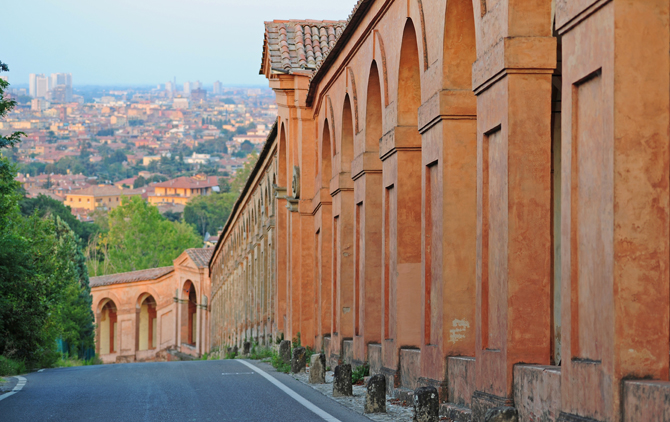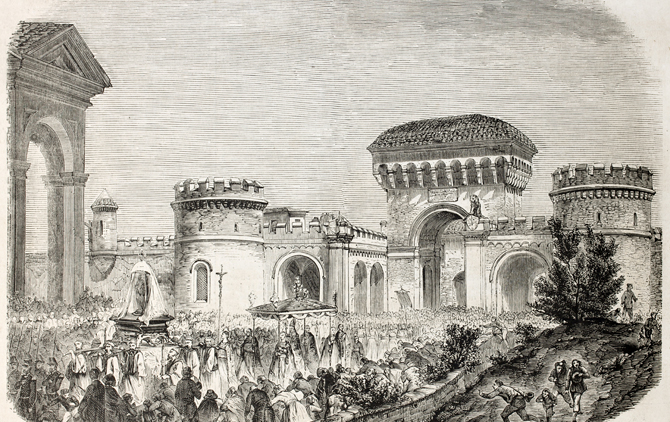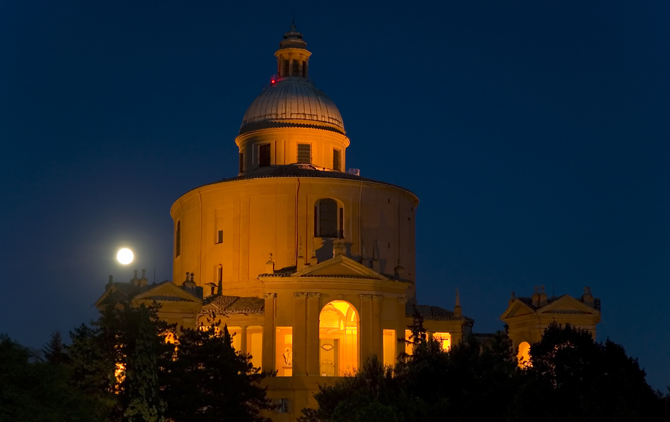The sanctuary of the Madonna of San Luca

Bologna - 10 June 2013 - Karina Mamalygo
Only two of the icons reputedly painted by St Luke the Evangelist coming from Constantinople are still in existence. One is the Virgin of Vladimir, one of the most venerated icons of the orthodox church, while the other is the Madonna of St Luke, housed in the sanctuary situated on a hilltop just outside the city of Bologna. Christian tradition claims that St Luke was the first icon painter however most probably both of these two icons are copies of ancient originals.
If you want to see the Madonna of Saint Luke you should visit the Colle della Guardia (the hill of the Guardwatch) at the end of the longest portico in the world. It is 3796 metres long with 666 arches and 15 chapels along the way. Supposedly the architect wanted 666 arches to suggest the idea of the Queen of Heaven crushing the Serpent: Satan.
The portico begins at the city’s Saragozza Gate and climbs to a height of 289 metres. Catholics believe that a pilgrim who has climbed to the top will receive pardon for all his or her sins.
According to legend, the icon was brought from the church of Santa Sophia in Constantinople by the Greek hermit Teocle Cminia in 1150. Supposedly when the hermit approached the icon which was hanging on a pillar under the dome, the Madonna herself appeared before him and told him to take this icon, painted by St Luke, “to the church on hill of the Guardia (Guardwatch)”.
However Teolcle had no idea where this place was. He journeyed through many countries and finally arrived in Rome where guided by the icon he found the ambassador from Bologna. The Bolognese noble explained how he could reach the hill and Teolcle left at once for Bologna. On the hill there was already a small church which had been built by a hermit who had apparently been averted to the imminent arrival of the icon. When Teolle reached Bologna he found the nobles and citizens waiting for him in order to celebrate the arrival of the icon and after three days of festivities on 8 May 1160 the icon was taken to the small church on the hill outside the city.
Unfortunately this original church of the reliquary no longer exists and there are also conflicting stories regarding its origins. According to certain documents the church was completed in 1194 and was blessed and consecrated by Pope Celestine III in the same year. The documents also mentioned the name of the hermit, Angelica Bonfantini requested to live as a hermit on the hill in 1192. Whatever the truth of the matter, what is sure is that the Church housing the Madonna became a sacred place and different monastic orders competed for the honour of guardianship.
The icon became associated with miracles. The most notable leaving its mark in common memory was the “Miracle of the Rain” in 1433. The spring and summer of that year had been marked by constant heavy rain which risked destroying all crops. The citizens decided to pray to the Madonna for an end to the devastation and the icon was taken in a procession down to the city. On 5th July, just as the procession arrived at the Saragossa Gate the downpour abruptly ceased and the crops were saved.
After this miracle pilgrims came from all over Italy to visit the Sanctuary and the procession became an annual event. Every second Saturday of May the icon is taken down to St Peter’s cathedral in a magnificent procession accompanied by prayers, and hymns sung by the faithful.
Like most other churches the sanctuary has undergone numerous modifications over the centuries. The church that you see today on the hilltop dates to 1751 and is by the architect Carlo Francesco Dotti. According to Girolamo Bianconi the author of a guidebook about Bologna in 1820, the restoration of the church cost 386 scudi which was an astronomical sum for that period. The sanctuary is in the form of a Greek cross with a magnificent dome, and the above the alter you will find the miraculous icon.
Between the 12th and 13th centuries it was repainted by a master from the School of Pisa in a more Italian style, however the lines and the position of the Madonna and Child are as they were originally. The silver background, the blue-green robes of the Madonna and the scarlet tunic of the child are protected by a silver casing which only reveals the two faces, however the whole icon can also be seen on painted copies and prints at the exit of the sanctuary. If you find yourself in Bologna don’t miss the opportunity to see one of the most sacred and admired the objects of the Christian world coming from Constantinople.














